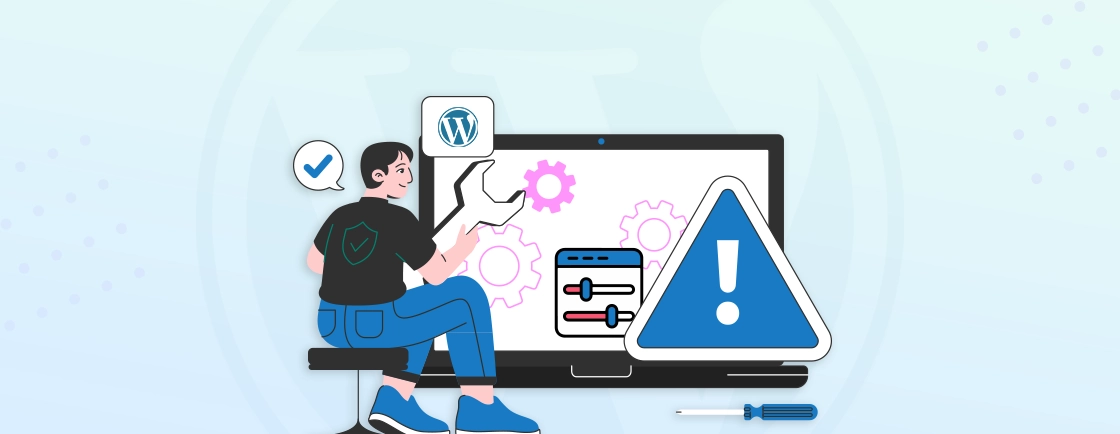Table of Contents
Adding an SSL certificate is the most significant implementation in WordPress security checklist. But what if your website still shows insecure assets from non-HTTPS URLs? That’s when you will see the mixed content warning on your WordPress website. So how do you fix that?
Well, there are a few different methods used by expert to identify and fix the cause of the mixed content error. But before jumping to it, let’s understand what this error is and its cause.
What is the Mixed Content Error in WordPress?
The Mixed Content Error in WordPress occurs when an HTTPS-secured website serves some resources over HTTP. This creates a situation where the page is not fully secure, as some elements are transmitted over an unsecured connection.
When mixed content is present, users may see alerts warning them about the insecure elements on the page. This can reduce the trust and credibility of your site. Now, let’s dive into the causes of mixed content errors.
Causes of Mixed Content Error in WordPress
The reason for the mixed content error is the inclusion of resources that are served over HTTP instead of HTTPS. Here are the common causes of these errors:
- Incomplete SSL Migration: This is a frequent issue after switching your WordPress site from HTTP to HTTPS. During this process, if you don’t update all the links referencing resources from HTTP to HTTPS, they’ll remain insecure and trigger mixed content warnings.
- Insecure Plugins or Themes: Some plugins or themes might include their own resources with HTTP links. If you’re using such elements, they’ll contribute to the mixed content issue.
- Hardcoded HTTP Links: In some cases, you might have manually inserted links within your website’s code or content editor using HTTP instead of HTTPS. This could be due to accidentally using the wrong protocol or copying links from an insecure source.
- CDN Misconfiguration: If you’re using a Content Delivery Network (CDN) to improve website performance, its settings might need to be adjusted to serve all content over HTTPS. By default, CDNs might not automatically switch resources to HTTPS if not explicitly configured.
- Database Issues: Rarely, database inconsistencies within WordPress can lead to mixed content errors. This could be due to serialized data containing outdated HTTP links or plugin settings that haven’t been properly updated during an SSL migration.
The Mixed Content Error in WordPress happens when an HTTPS site loads some resources over HTTP, making the page partially insecure. It is usually caused by incomplete SSL migration, insecure plugins/themes, hardcoded HTTP links, or CDN misconfigurations. Looking to secure your WordPress site and fix mixed content errors? Partner with a WordPress development company to optimize your website and ensure a seamless HTTPS experience.
How to Identify the Mixed Content Error in WordPress?
Identifying mixed content errors in WordPress involves using two methods: using a developer tool and checking websites manually.
Method 1: Using Browser Developer Tools
Most modern browsers have built-in developer tools that can help diagnose website issues, including mixed content errors. Here’s a general guideline (specific steps might vary slightly depending on your browser):
- Open the webpage on your WordPress website where you suspect the mixed content error.
- Right-click anywhere on the page and select “Inspect” or “Inspect Element”.
- This will open the developer tools window, typically at the bottom of your screen.
- Navigate to the “Console” tab.
- Refresh the webpage.
If there are any mixed content errors, you’ll see warnings or error messages displayed in the console. These messages will usually pinpoint the specific resources (such as image URLs) causing the issue, which can be why images aren’t displaying.
Method 2: Checking Your Website Content
While developer tools provide a more technical approach, you can manually check your website content for potential mixed content issues. Here’s what to look for:
- Review your posts and pages: Look for any embedded images, videos, or other resources that have “http://” at the beginning of their URL instead of “https://”. This issue sometimes overlaps with images not showing, videos not playing, or other resources not loading.
- Inspect theme and plugin files: If you’re comfortable with the code, you can examine your theme and plugin files for any hardcoded HTTP URLs referencing resources.
You can identify mixed content errors in WordPress using browser developer tools, which show insecure resources in the console, or by manually checking content for HTTP links. Both methods help pinpoint and fix insecure elements.
How to Fix the Mixed Content Error in WordPress?
Mixed content errors occur when resources on a WordPress site are loaded over HTTP on an HTTPS page. This can lead to security warnings in browsers and a less secure site overall. Here are three methods to fix these errors.
Method 1: Using a Plugin
Installing a WordPress plugin is usually the easiest, most efficient way to implement features and solve issues in WordPress websites. And this method can also help you fix mixed content errors in WordPress. Plugins automate the process of identifying and replacing insecure HTTP URLs with secure HTTPS URLs.
Step 1: Choose a Plugin
There are several plugins available in the official repository. But choose the right plugin according to your requirements. Here are a few good options:
- SSL Insecure Content Fixer: Offers various levels of automatic fixing for mixed content errors.
- Really Simple SSL: Simplifies enabling SSL and redirects your website from HTTP to HTTPS.
Step 2: Install and Activate the Plugin
- Log in to your WordPress dashboard.
- Navigate to Plugins → Add New.
- Search for your chosen plugin and click Install Now.
- Once installed, click Activate.
Step 3: Configure the Plugin
- Once activated, go to Settings → SSL.
- The plugin will automatically detect your site settings and make necessary adjustments to enforce HTTPS.
- Follow the on-screen instructions to complete the setup.
Step 4: Verify and Test
Now, you should check your site using browser developer tools to ensure there are no mixed content warnings. Use online tools like Why No Padlock to scan your site for any remaining issues.
This method is ideal for beginners who want a quick and automated solution.
Method 2: Updating Links
This method includes updating all insecure links within your website content and files to ensure a secure connection.
Step 1: Update URLs in the WordPress Settings
- Go to Settings → General.
- Ensure that both WordPress Address (URL) and Site Address (URL) are set to HTTPS.
- Click Save Changes.
Step 2: Search and Replace HTTP URLs in the Database
- Install and activate the Better Search Replace plugin.
- Go to Tools → Better Search Replace.
- In the Search for field, enter http://yourdomain.com.
- In the Replace with field, enter https://yourdomain.com.
- Select all tables and run a dry run to see the changes.
- If everything looks correct, run the actual replacement.
Step 3: Update Theme and Plugin Files
- Go to your theme files and update any hardcoded HTTP URLs to HTTPS. Check files like header.php, footer.php, and functions.php.
- Review plugin settings for any HTTP URLs and update them to HTTPS.
Step 4: Update Media Library Links
Here, we will use the Velvet Blues Update URLs plugin to update URLs in your WordPress media library:
- Install and activate the plugin.
- Go to Tools → Update URLs.
- Enter your old URL (http://yourdomain.com) and new URL (https://yourdomain.com).
- Select which URLs to update and click Update URLs Now.
This method addresses the issues by directly replacing HTTP URLs in your site settings, database, and theme or plugin files. It offers more control and performance benefits but requires some technical knowledge.
Method 3: Altering the .htaccess File
Editing the .htaccess file to enforce HTTPS for all resources. This ensures that all HTTP requests are redirected to HTTPS.
Step 1: Backup Your .htaccess File
Before making any changes, ensure you backup your WordPress website, especially the .htaccess file.
Step 2: Edit the .htaccess File
- Access your website’s root directory via FTP client or using your hosting cPanel.
- Open the .htaccess file for editing.
Step 3: Add Redirect Rules
Add the following code to redirect all HTTP traffic to HTTPS:
<IfModule mod_rewrite.c>
RewriteEngine On
RewriteCond %{HTTPS} off
RewriteRule ^(.*)$ https://%{HTTP_HOST}%{REQUEST_URI} [L,R=301]
</IfModule>
Step 4: Save and Upload the File
- Save the changes to your .htaccess file.
- Upload the updated file back to your server if you are using an FTP client.
This method ensured that any remaining HTTP requests were redirected to HTTPS, preventing mixed content errors. This method is effective for ensuring that no HTTP resources are loaded on your site.
Conclusion
Fixing the mixed content error in WordPress is a step towards website security. By understanding the source of cause, you will be able to take steps for finding the issue. To fix the issue in a user-friendly way, you can use plugins like Really Simple SSL. It provides an automated solution perfect for beginners.
If you don’t have technical expertise to update the links manually or alter the .htaccess file for better control, you can hire WordPress developers who follow the best security and maintenance practices when building your site.
FAQs About Fixing Mixed Content Error in WordPress
Which is the Best Plugin to Fix Mixed Content Errors?
Really Simple SSL is highly recommended for fixing mixed content errors. It automatically detects your settings, updates URLs, and enforces HTTPS across your site. Better Search Replace and SSL Insecure Content Fixer are also useful for addressing specific URL issues.
Will Fixing Mixed Content Errors Improve My Site’s SEO?
Fixing mixed content errors can indirectly improve your site’s SEO. Browsers may rank secure sites higher and display security warnings for sites with mixed content. A fully secure site enhances user trust and experience, potentially boosting your SEO.
Create with WordPress CMS
Build flexible and scalable websites using WordPress's powerful content management system.





